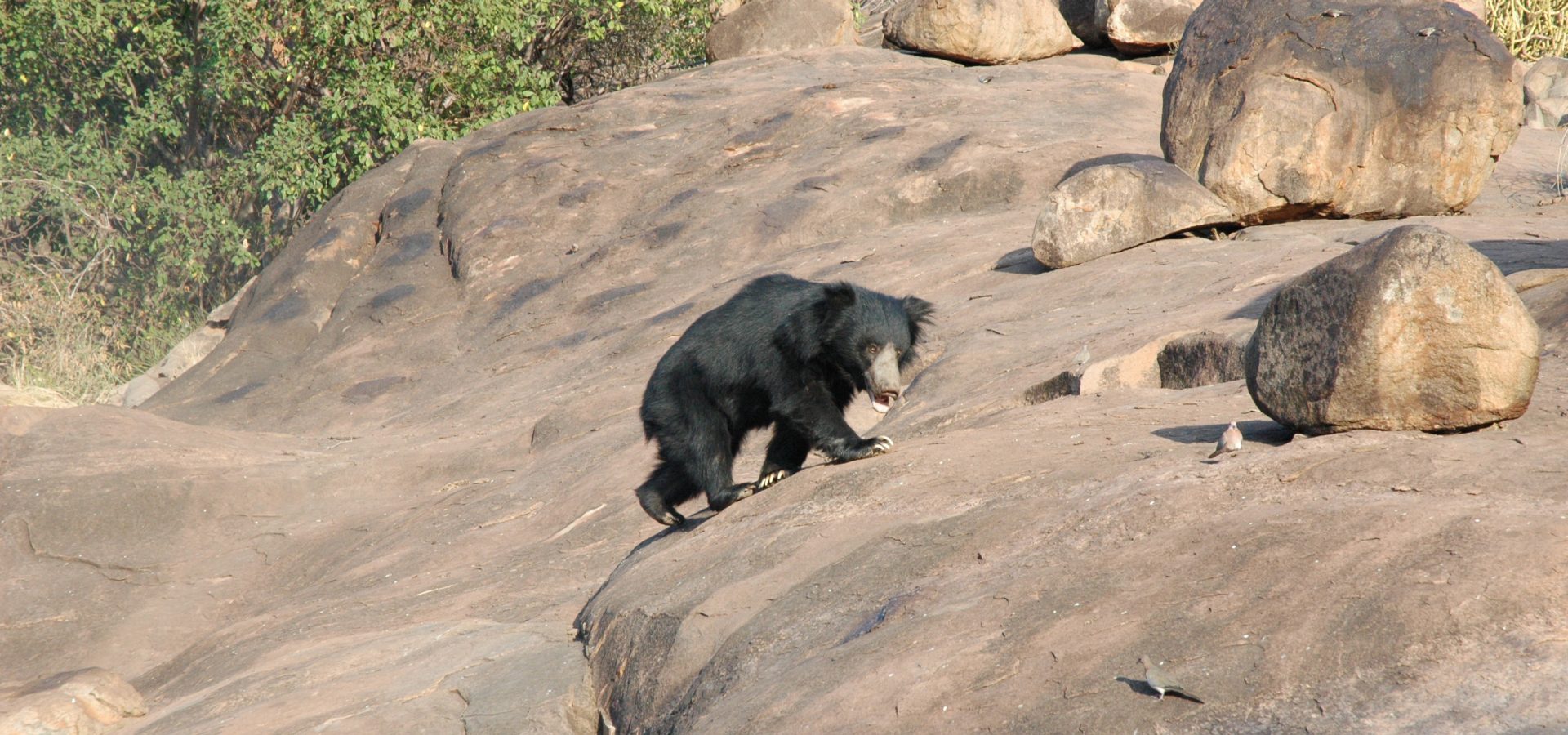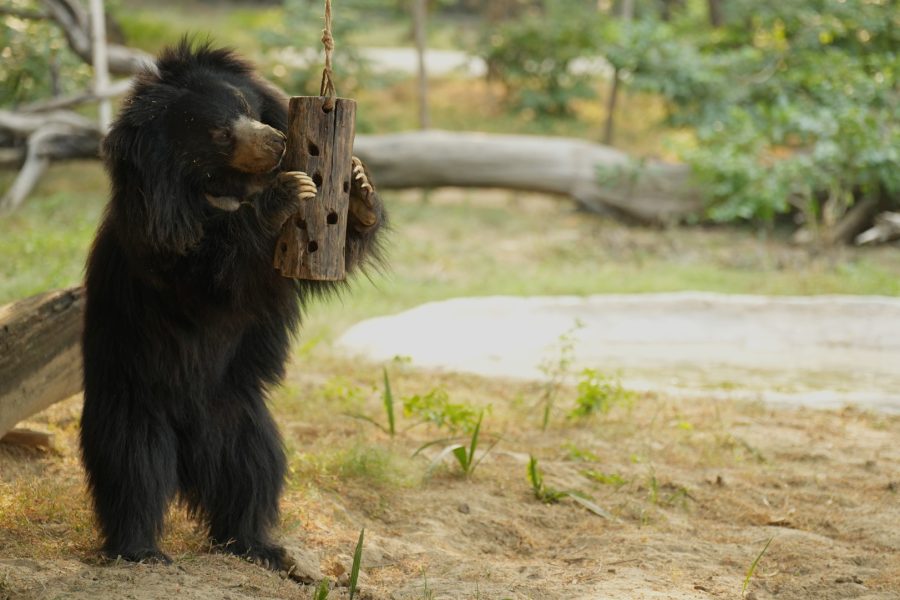Widely distributed across the Indian subcontinent, sloth bears are one of the eight bear species in the world. In India, the Western Ghats and central states are the strongholds of their population, which is estimated to be between 6,000 to 11,000. Unfortunately, this endemic species faces severe threats due to habitat loss and fragmentation. Degradation of habitats diminishes food sources and drives the bears to human-dominated landscapes.
In Karnataka particularly, the sloth bear population is severely fragmented owing to rampant development, cultivation, plantation, and mining activities. In fact, in some regions, the population has also been locally extirpated. Gudekote Sloth Bear Sanctuary is itself fragmented into five regions, with villages perforating the entire protected area. In search of adequate natural resources like water, food, and shelter, sloth bears move across these patches inhabited by humans. As their forest habitats dwindle, more and more sloth bears search for new dwellings by frequently venturing outside spaces classified as protected areas. This eventually leads to an increase in human-wildlife conflict that affects humans and bears alike.
Need for Sloth Bear Research
The sloth bear is protected in Schedule I of the Indian Wildlife (Protection) Act, 1972 and is listed as ‘Vulnerable’ in the IUCN Red List. A member of the Ursidae family, the species generally resides in forested patches with rocks and boulders to shelter them during rain and hot weather. Being myrmecophagous animals, sloth bears feed on termites or ants, but they also indulge in fruits and honey. They serve an important role in the ecosystem by dispersing plant seeds and enabling habitat regeneration.
However, frequent cases of conflict with sloth bears have developed fear and negative perception among locals. Thus, it is important to generate habitat and species-specific management strategies for sloth bears. Understanding the current status, distribution, home range, population, and ecology of sloth bears is the need of the hour. This can further be used by conservation policymakers including the government, forest departments, researchers, and organisations to declare certain regions as protected areas.
Research Study by Wildlife SOS
For the last decade, Wildlife SOS has been working tirelessly to study bears, perform conflict mitigation and ensure the future of these bears in the wild. Wildlife SOS recently embarked on a large-scale habitat study of the nocturnal sloth bears using GPS or Global Positioning System collars. The research aimed to understand the movements, population, home range, habitat selection, and distribution of the elusive bears within areas that hold good populations. Three districts namely Bellary, Kopal, and Tumkur in Karnataka were targeted to identify factors leading to human‐sloth bear conflict. The goal of the research project is also to identify the causes and nature of human-bear conflict through a survey.
Based on intensive analysis, a plan to radio-collar a total of ten sloth bears has been devised by our team as part of a five-year-long project. Their location and movement will be tracked remotely through GPS signals, as well as VHF (very high frequency) signals from the field. Data gleaned from these will help us know more about the use of habitat corridors and critical resources like water, the competition for such resources with cattle and people, and the effect of constructions like roads. Radio telemetry will enable the research team to understand how individual bears interact with one another and their natural environment. Additionally, the team will study indirect signs such as scat, foraging, and pugmarks, to monitor the sloth bear population.
For insight into conflict, the bear movement study will help the team learn about the crop species damaged, along with the extent and time of damage. This data will further enable the management to develop strong conflict mitigation strategies to avoid losses.
Radio Collaring Sloth Bears
To initiate radio collaring of sloth bears, the team first conducted a study in the scrub forest and rocky granite boulders of the Gudekote Sloth Bear Sanctuary. Spread over 167 km sq area, this sanctuary is situated in the Bellary district of Karnataka. With the intention of protecting sloth bears in the area, it was declared a sanctuary in 2013, making it Asia’s second sloth bear sanctuary.
Using camera traps, the most frequently visited areas were identified and barrel traps were then laid out in those locations. Sweet treats like honey, jackfruit, and jaggery syrup were smeared on the barrels for a week in order to lure and habituate bears. The camera trap recordings was also used to assess the time of the bears’ visit and the identification of individuals. Based on the above information, a suitable day was decided to radio-collar the bears. On this day, the doors of the barrel traps were set in a particular position.
Once the bears were inside the barrels, they were tranquilised under the professional assistance of the Wildlife SOS veterinarian team and forest department personnel. The collaring procedure took nearly an hour to complete. After the radio collars were attached, the animals were observed for 4-6 hours to assess their behavioural response to the collars before they were released back into the wild.
Radio collars use a satellite tracking system to provide information about their activity. The tracking data produces details about their home range, habitat choices, and travel patterns. Data on bear presence and habitat use is essential to predict locations likely to be populated by them. Our team believes that this radio-collaring project, combined with a survey of the local population’s attitudes towards sloth bears, can pave the way to sustainable human-bear relations in future.
The sloth bear research conducted by Wildlife SOS aims to gain an understanding of the species so that we can better conserve them. Being one of the least studied and barely understood bear species, finding appropriate ways to conserve them remains difficult. Understanding threats they face is key to our efforts as it allows us to build programmes to mitigate those threats. You can support the research work that our team does for sloth bear conservation by making a donation.





